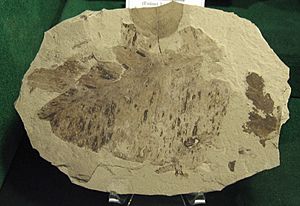Orontium wolfei facts for kids
Quick facts for kids Orontium wolfei |
|
|---|---|
 |
|
| Fossil Orontium wolfei | |
| Scientific classification | |
| Genus: |
Orontium
|
| Species: |
wolfei
|
Orontium wolfei was an ancient plant, a type of "golden-club." It's now extinct, meaning it doesn't live anymore. Scientists found its fossilized leaves in places like Washington, USA, and British Columbia, Canada. This plant is part of the same group as today's golden-club plants, which are still alive.
Discovering Orontium wolfei
Scientists found Orontium wolfei fossils in special rock layers. These layers are called the Allenby Formation and the Klondike Mountain Formation. The very first place where these fossils were found was near Princeton, British Columbia, at a spot called "One mile Creek." More fossils were also discovered nearby at Lamont Creek.
The rocks from the Allenby Formation are from the Early Eocene period. This means they are very, very old! Scientists figured out their age using a special method called radiometric dating. This method looks at tiny crystals in the rocks to tell how old they are.
Other fossils of O. wolfei were found in the Klondike Mountain Formation. These rocks are also from the Eocene period, about 48 to 49 million years ago. Before O. wolfei was officially named, some of its fossils were thought to be from a different ancient plant group called Zingiberopsis. This was because their leaves looked similar. A scientist named Jack A. Wolfe made this early identification. He studied many plant fossils from western North America.
Naming the Plant
The official description of Orontium wolfei happened in 2007. A team of scientists, led by Josef Bogner, studied the fossils. They published their findings in a science journal called Zitteliana.
The main fossil used to describe the species is called the holotype. It's like the "original" example for the species. This special fossil is kept safe in a museum in Denver, Colorado. The plant was named wolfei to honor Jack A. Wolfe. This was a way to recognize his important work studying ancient plants in North America.
What Orontium wolfei Looked Like
The leaves of Orontium wolfei were long and oval-shaped. They could be anywhere from about 7 inches (170 mm) to over 17 inches (450 mm) long. They were also fairly wide, ranging from 2 to 6 inches (50 to 150 mm).
Scientists haven't found a complete leaf yet, so they don't know the full length of the largest leaves. They also don't know exactly how the leaf stem (called a petiole) was structured. The tips of the leaves were shaped like a hood. The veins in the leaves ran mostly side-by-side, and the main vein in the middle was hard to see. Many smaller veins connected to form a mesh-like pattern. This special pattern of veins is a key feature of the Araceae plant family, which helped scientists confirm where Orontium wolfei belonged.

